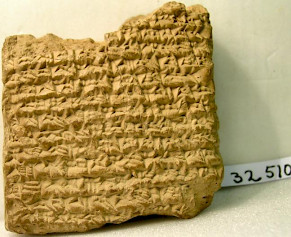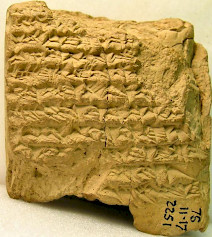BCHP 15 (Gold Theft Chronicle)
The Chronicle Concering the Theft of Gold from the Day One Temple, or Gold Theft Chronicle (BCHP 15) is one of the Mesopotamian chronicles written in ancient Babylonia in the Hellenistic Period.

The Chronicle Concering the Theft of Gold from the Day One Temple, or Gold Theft Chronicle (BCHP 15) is one of the Mesopotamian chronicles written in ancient Babylonia in the Hellenistic Period. The cuneiform tablet (BM 32510) is in the British Museum. The tablet can be dated to SE 150/151 (=162/1 BCE) ands belongs therefore to the brief reign of the Seleucid king Antiochus V Eupator (164-162).
On this webpage, a new reading is proposed; the official publication will be in I.L. Finkel, R.J. van der Spek, R. Pirngruber, Babylonian Chronographic Texts from the Hellenistic Period (2020; = BCHP; Writings of the Ancient World).
Description of the tablet
A small one-column tablet, BM 32510 (= 76-11-17, 2251), more or less square, dealing with a brief period, one year at most.
The preserved length of the tablet is 4.0 – 4.9 cm, the width is 4.5 cm, the thickness 1.7 cm. The upper edge is crumbled off, but signs of line 1 are preserved. The left edge is preserved, but uninscribed; the right edge is also preserved. Eight lines continue on the right edge. The lower edge is mutilated and was possibly inscribed. The lower end of the reverse was left blank with room for 1.5 or 2 lines.
Commentary

The chronicle is to be dated to Antiochus IV Epiphanes or later, but probably to Antiochus V Eupator. An Antiochus is mentioned in Rev. 11. The mentioning of politai makes Antiochus IV the first candidate and the content of the tablet reminds us of the temple robbery mentioned in the Astronomical Diaries.note In that diary the appointment of a zazakku (financial official, prostates) is reported, which seems to be a new function. In our chronicle the zazakku is in function, so that this chronicle postdates this diary.
This diary also concerns temple robbery but our chronicle obviously refers another incident. Theft of temple property is recorded fairly regularly.note The fact that the chronicle mentions a "governor of the king" (šakin ša šarri), points to the reign of Antiochus V. That office is only recorded during his reign and may regard the guardian of the minor king, appointed by Antiochus IV on his deathbed, Philip or Lysias.note
Since it is likely that the death of an Antiochus is mentioned, the death of Antiochus V will be at issue. If so, the chronicle should be dated to a month between 1 VIII 150 and 22 VI 151 SE = 29 October 162-9 September 161 BCE.note The death of Antiochus V was violent. His reign had been contested from the start by Demetrius I Soter, son of Seleucus IV, who was kept in Rome as hostage. He escaped, landed in Tripolis, acquired a lot of support and Antiochus, who just had conquered Antioch from Philippus, was handed over to Demetrius and upon his orders executed.note
Obverse
[Obv.1] [.. .. .. .. .. .. .. .. ..] x x [.. ..]
[Obv.2] [.. .. .. .. .. .. .. at the comma]nd of a certain dignitary of the satrap of Akkad
[Obv.3] [gold? to? .. .. .. .. .. .. the assem]bly? of Esagila was given.
[Obv.4] That day into the Day-One-temple they made it enter (and) they put it there.
[Obv.5] A festival they held. Day 13th, Barabut-Bel, the smith,
[Obv.6] who had been pursued? by the governor of the king since the middle of the year,
[Obv.7] was imprisoned on account of the gold aforementioned. That month,
[Obv.8] day 21th, at the command of a certain dignitary of the strategos of Akkad,
[Obv.9] the trustee (bêl piqitti) (of), the financial official (zazakku) and the Babylonians of the Council (kiništu) of Esa[gila],
[Obv.10] one had brought outside the gold in question from the Day-One-Temple.
[Obv.11] When it was weighed[12] with the weight stones of the house of the goldsmiths, with which it had been weighed in the past,
[Obv.12] it was diminished by 2/3 mina and 6 ½ shekels [26.5 shekels].
[Obv.13] That month, day 22!? the thie[ves ] afore[mentioned]
[Obv.14] in the presence of the dignitary in question and the x x x
[Obv.15] and the.. .. x x x [.. .. .. .. .. .. .. .. .. .. ..]
[Edge mutilated; possibly inscribed.]
[Rev.1] and the šat[ammu of Esagila]
[Rev.2] and the Babylonians (of) the [Council of Esagila?, the judge]
[Rev.3] of the king on a rack of inter[rogation]note
[Rev.4] interrogatedsg them and con[victed them.]
[Rev.5] Their prisoners [were taken to GN] below Babyl[on and]
[Rev.6] were burned with fire. That month [day .. .. ..]
[Rev.7] the politai wooden?? [.. ..]
[Rev.8] of the ships? above Babylon in fro[nt (of x (x))]
[Rev.9] of the palace of the king they repaired?
[Rev.10] [Month MN. /That month\ I heard
[Rev.11] [as follows: A]ntiochus,
[Rev.12] [the king, was killed??] (vacat)